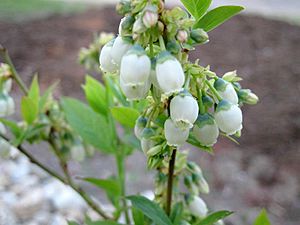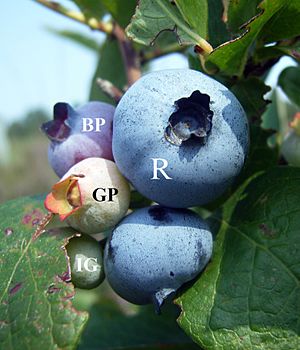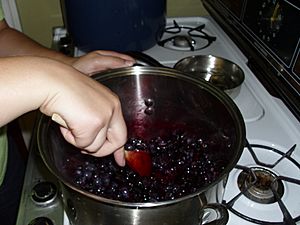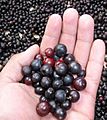Blueberry facts for kids
Quick facts for kids Blueberry |
|
|---|---|
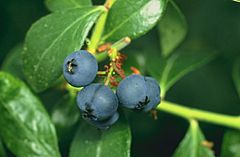 |
|
| Blueberry fruit | |
| Scientific classification | |
| Kingdom: | |
| Division: | |
| Class: | |
| Order: | |
| Family: | |
| Genus: | |
| Section: |
Cyanococcus
Rydb.
|
A blueberry is a small, tasty berry. It grows on a type of woody plant called a shrub. Many kinds of blueberries grow naturally in North America and eastern Asia. You can usually find fresh blueberries between May and October.
Blueberries taste sweet, with a little bit of sourness. Wild blueberries often have an even stronger flavor. People love to use blueberries to make jelly, jam, pies, muffins, and many other yummy foods. The most common type grown for eating is the northern highbush blueberry. Some berries look similar to blueberries, like huckleberries.
Contents
What are Blueberries?
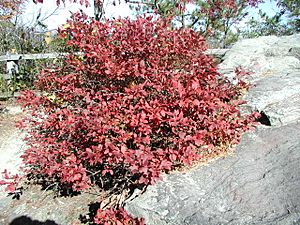
Most blueberries you see in stores come from plants that grow naturally in North America. But there are other similar berries around the world. These include huckleberries and whortleberries in North America. In Europe, you might find bilberries. These berries look a lot like blueberries and are sometimes used in similar ways.
You can tell a true blueberry from a bilberry by looking inside. If you cut a ripe blueberry in half, its flesh will be light green. But bilberries, whortleberries, and huckleberries are red or purple all the way through.
Blueberry Nutrition Facts
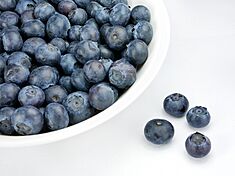 |
|
| Nutritional value per 100 g (3.5 oz) | |
|---|---|
| Energy | 240 kJ (57 kcal) |
|
14.49 g
|
|
| Sugars | 9.96 g |
| Dietary fiber | 2.4 g |
|
0.33 g
|
|
|
Protein
|
0.74 g
|
| Vitamins | Quantity
%DV†
|
| Vitamin A equiv.
beta-Carotene
lutein zeaxanthin
|
0%
32 μg80 μg
|
| Vitamin A | 54 IU |
| Thiamine (B1) |
3%
0.037 mg |
| Riboflavin (B2) |
3%
0.041 mg |
| Niacin (B3) |
3%
0.418 mg |
| Pantothenic acid (B5) |
2%
0.124 mg |
| Vitamin B6 |
4%
0.052 mg |
| Folate (B9) |
2%
6 μg |
| Vitamin C |
12%
9.7 mg |
| Vitamin E |
4%
0.57 mg |
| Vitamin K |
18%
19.3 μg |
| Minerals | Quantity
%DV†
|
| Calcium |
1%
6 mg |
| Iron |
2%
0.28 mg |
| Magnesium |
2%
6 mg |
| Manganese |
16%
0.336 mg |
| Phosphorus |
2%
12 mg |
| Potassium |
3%
77 mg |
| Sodium |
0%
1 mg |
| Zinc |
2%
0.165 mg |
| Other constituents | Quantity |
| Water | 84 g |
|
Link to USDA Database entry
|
|
| †Percentages estimated using US recommendations for adults. | |
Blueberries are mostly water (84%). They contain carbohydrates (14%) and a small amount of protein (1%). They have very little fat.
A 100-gram serving of blueberries provides 57 calories of food energy. They are a good source of vitamin K, vitamin C, and manganese. They also contain other important nutrients in smaller amounts.
Growing Blueberries
Blueberries can be grown on farms, or they can be picked from wild bushes. In North America, the most common type grown is the northern highbush blueberry. There are also special types that grow well in warmer southern U.S. climates.
"Wild" blueberries are smaller than the ones grown on farms. They have a very strong, rich color. These wild blueberries grow in places like eastern Canada and parts of the U.S. In some areas, they cover huge fields, creating "blueberry barrens." Some First Nations communities in Ontario still gather these wild blueberries.
When you see "wild" on a blueberry package, it means they come from natural fields. These bushes are not planted by people. Instead, they are cared for by pruning or burning them every two years. This helps the plants grow better.
When are Blueberries Harvested?
The time when blueberries are picked in North America changes. It can start as early as May and usually finishes in late summer. In countries like Australia, Chile, and New Zealand, the harvest season is much longer. For example, in Australia, fresh blueberries are available for 10 months of the year! This is thanks to different farms and new growing methods.
Farmers can also store picked blueberries in special cool places. This helps keep them fresh for longer. In the UK, blueberries are picked from June to August. Mexico also has a harvest season from October to February.
How are Blueberries Picked?
In the past, people picked blueberries by hand or with special rakes. Today, many farmers use machines for cultivated blueberries. These machines gently shake the fruit off the bushes. New machines are also being made for wild, lowbush blueberries.
After picking, the fruit goes to a facility. Here, they are cleaned, packaged, and then sent to stores. In Mexico, some farmers pack their berries right on the farm. They then sell them directly or store them until they are sold. In Europe, blueberries are often grown in tunnels. This helps extend the growing season. It also allows farmers to sell their crops earlier or later in the year to get better prices.
How We Use Blueberries
Blueberries are sold fresh, or they can be frozen quickly. They are also made into purées or juice. Sometimes, they are dried or soaked in juice. These processed blueberries are used in many foods. You can find them in jellies, jams, blueberry pies, muffins, and even breakfast cereals.
Blueberry jam is made from blueberries, sugar, water, and fruit pectin. Blueberry sauce is a sweet sauce that uses blueberries as its main ingredient.
You can even make blueberry wine! This wine is made from the fruit's flesh and skin. It is fermented and then aged. Usually, the smaller, wild lowbush blueberries are used for wine.
Images for kids
-
Wild blueberry fields in Nova Scotia, Canada
-
Vaccinium meridionale, a wild species found in the Andes
-
A cut blueberry showing how, having been frozen and then thawed, the anthocyanins in the pericarp are able to run into the damaged cells, staining the flesh.
-
Blueberry harvester in Michigan


